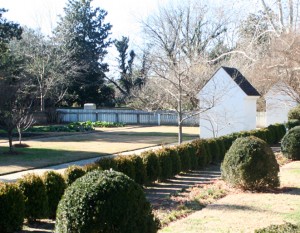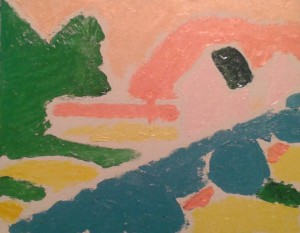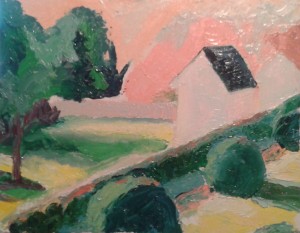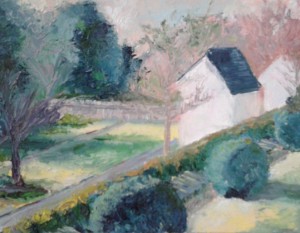In an effort to get out of my writing chair, I recently began taking an impressionist painting course with local artist, Mark Hierholzer. Each week I have joined two friends, and I have stood before a canvas, trying to paint light. Not color. Not scenes. Not objects. Light.
The approach for this type of impressionist painting goes something like this: (see the images below)
Step one: look for light in terms of shapes. When you squint, where are the tones or shadows melding together? Paint those–just four to six shapes total.
Step two: now where is the next layer of light? Or the next division of light and shadow? The sides of the shrubs? In the grass or trees? Paint that.
Step three: (which also might happen four or five more times), add detail lighting. The blue path, the foreground trees. Always searching for what the light is doing. Where it is. Where it isn’t.
While my painting skills have a long way to go, I put the emphasis on the word light, because after each three hour class, what I end up feeling is light. All my hours of sitting and writing and worry slide away. We listen to classical music. Drink wine or coffee. Laugh. And we focus on the light. In life, I think I will choose to make this my focus, too. And so, painting leaves a great impression.
(Sorry, could not resist the pun. Nor could I resist the subject of my first landscape painting. These are the necessaries–outhouses–at the Wythe House in Williamsburg.)




4 Comments on Looking for Light
Comments are closed.

Nicely done, Karen.
Thank you so much, Diane. Mark is a patient teacher, and it feels like playtime.
Thanks Karen for you explanation and examples of your work. I have modeled for Mark’s impressionist classes in Swan Quarter and can attest to his talent as an artist and a teacher. At first, I wondered what his students were painting because what they were doing, at first—did not look like me. But, by the end of just a few lessons the end results were individual and creative use of color—showing the essence of what was inside me.
Jean – It does seem that way. When the first layer of paint goes down, I wondered how on earth it would end up looking like a garden. We did portrait work a couple of weeks ago, and clearly I need more experience in that arena. Thanks for coming along and commenting.